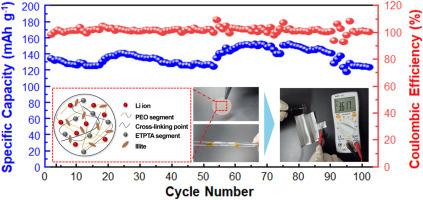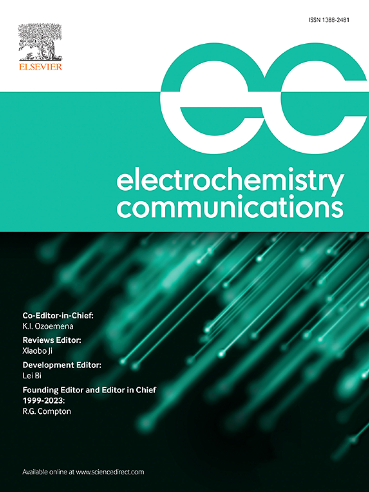柔性全固态锂金属电池用伊利石填料机械增强固态聚合物电解质
IF 4.2
3区 工程技术
Q2 ELECTROCHEMISTRY
引用次数: 0
摘要
固态电解质由于其高安全性、机械稳定性和与锂金属阳极的兼容性而引起了人们的极大关注,使其成为下一代全固态电池发展的关键部件。聚合物基固体电解质(pse)具有柔韧性、可加工性和与电极良好的界面接触等优点,但结构稳定性较低。本研究以乙氧基化三甲基丙烷三丙烯酸酯和膨胀伊利石(EI)功能填料为原料,采用光聚合法制备了pse。以4 wt% EI合成的PSE在25°C时的离子电导率为2.31 × 10−4 S cm−1,以PSE为电解质的全固态Li/NCM622纽扣电池在0.1C时的放电容量为129.5 mAh g−1,库仑效率为98%。此外,含有ei的PSE表现出更好的机械强度,使柔性全固态锂金属电池袋芯的制造成为可能。本研究为使用粘土基填料的聚乙烯基复合材料的设计提供了有价值的见解。本文章由计算机程序翻译,如有差异,请以英文原文为准。

Mechanically reinforced solid-state polymer electrolyte using illite filler for flexible all-solid-state Li-metal batteries
Solid-state electrolytes have attracted significant attention due to their high safety, mechanical stability, and compatibility with lithium metal anodes, making them a critical component in the development of next-generation all-solid-state batteries. Polymer-based solid electrolytes (PSEs) offer advantages such as flexibility, processability, and good interfacial contact with electrodes but suffer from low structural stability. In this study, PSEs were fabricated by photopolymerization from ethoxylated trimethylolpropane triacrylate and expanded illite (EI) functional filler. The PSEs synthesized with 4 wt% EI show a favorable ionic conductivity of 2.31 × 10−4 S cm−1 at 25 °C and an all-solid-state Li/NCM622 coin cell using the PSE as the electrolyte delivered a discharge capacity of 129.5 mAh g−1 at 0.1C with 98 % Coulombic efficiency. In addition, the EI-containing PSE exhibited improved mechanical strength, enabling the fabrication of a flexible all-solid-state Li-metal battery pouch cell. This study offers valuable insight into the design of PSEs using clay-based fillers.
求助全文
通过发布文献求助,成功后即可免费获取论文全文。
去求助
来源期刊

Electrochemistry Communications
工程技术-电化学
CiteScore
8.50
自引率
3.70%
发文量
160
审稿时长
1.2 months
期刊介绍:
Electrochemistry Communications is an open access journal providing fast dissemination of short communications, full communications and mini reviews covering the whole field of electrochemistry which merit urgent publication. Short communications are limited to a maximum of 20,000 characters (including spaces) while full communications and mini reviews are limited to 25,000 characters (including spaces). Supplementary information is permitted for full communications and mini reviews but not for short communications. We aim to be the fastest journal in electrochemistry for these types of papers.
 求助内容:
求助内容: 应助结果提醒方式:
应助结果提醒方式:


